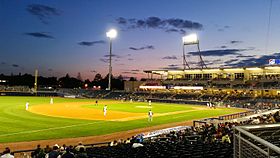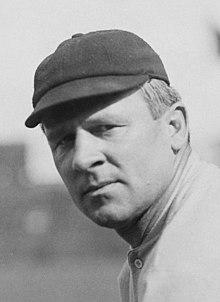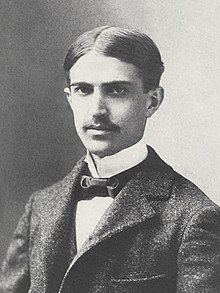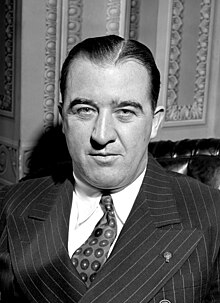Portal:Baseball
Portal maintenance status: (June 2018)
|
| Main page | Content, Categories & Topics | WikiProjects & Things you can do |
The Baseball Portal
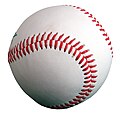
Baseball is a bat-and-ball sport played between two teams of nine players each, taking turns batting and fielding. The game occurs over the course of several plays, with each play generally beginning when a player on the fielding team, called the pitcher, throws a ball that a player on the batting team, called the batter, tries to hit with a bat. The objective of the offensive team (batting team) is to hit the ball into the field of play, away from the other team's players, allowing its players to run the bases, having them advance counter-clockwise around four bases to score what are called "runs". The objective of the defensive team (referred to as the fielding team) is to prevent batters from becoming runners, and to prevent runners' advance around the bases. A run is scored when a runner legally advances around the bases in order and touches home plate (the place where the player started as a batter).
The opposing teams switch back and forth between batting and fielding; the batting team's turn to bat is over once the fielding team records three outs. One turn batting for each team constitutes an inning. A game is usually composed of nine innings, and the team with the greater number of runs at the end of the game wins. Most games end after the ninth inning, but if scores are tied at that point, extra innings are usually played. Baseball has no game clock, though some competitions feature pace-of-play regulations such as the pitch clock to shorten game time.
Baseball evolved from older bat-and-ball games already being played in England by the mid-18th century. This game was brought by immigrants to North America, where the modern version developed. Baseball's American origins, as well as its reputation as a source of escapism during troubled points in American history such as the American Civil War and the Great Depression, have led the sport to receive the moniker of "America's Pastime"; since the late 19th century, it has been unofficially recognized as the national sport of the United States, though in modern times is considered less popular than other sports, such as American football. In addition to North America, baseball spread throughout the rest of the Americas and the Asia–Pacific in the 19th and 20th centuries, and is now considered the most popular sport in parts of Central and South America, the Caribbean, and East Asia, particularly in Japan, South Korea, and Taiwan. (Full article...)
 Featured articles - load new batch
Featured articles - load new batch
-
Image 1
Herschel Greer Stadium was a Minor League Baseball park in Nashville, Tennessee, on the grounds of Fort Negley, an American Civil War fortification, approximately two mi (3.2 km) south of the city's downtown district. The facility closed at the end of the 2014 baseball season and remained deserted for over four years until its demolition in 2019. Following an archaeological survey, the land is expected to be reincorporated into Fort Negley Park.
Greer was opened in 1978 for the Nashville Sounds, an expansion franchise of the Double-A Southern League who moved to the Triple-A American Association in 1985 and to the Triple-A Pacific Coast League in 1998. The stadium played host to the team until 2014. The subject of numerous upgrades and repairs to maintain its functionality, Greer became one of the oldest stadiums used by a Triple-A team and had fallen well below professional baseball's standards for a stadium at that class level by the end of its use. For over a decade, the Sounds attempted to secure agreements with the Metropolitan Government of Nashville and Davidson County for a new ballpark to replace Greer, eventually resulting in the construction of First Tennessee Park, which became the Sounds' new home in 2015. (Full article...) -
Image 2
Arthur Joseph Houtteman (August 7, 1927 – May 6, 2003) was an American right-handed pitcher in Major League Baseball who played for 12 seasons in the American League with the Detroit Tigers, Cleveland Indians and Baltimore Orioles. In 325 career games, Houtteman pitched 1,555 innings and posted a win–loss record of 87–91, with 78 complete games, 14 shutouts, and a 4.14 earned run average (ERA).
Known on the sandlot for his pitching motion, Houtteman was signed by scout Wish Egan in 1945 at 17 years of age. He was recruited by major league teams, and joined a Tigers pitching staff that had lost players to injuries and World War II. After moving between the major and minor leagues over the next few years, he was nearly killed in an automobile accident just before the 1949 season. Houtteman rebounded from his injuries and went on to win 15 games that season and made his only All-Star appearance in the following year. (Full article...) -
Image 3

On July 10, 1932, the Philadelphia Athletics beat the Cleveland Indians 18–17 in 18 innings in a Major League Baseball game played at League Park in Cleveland. Several major-league records were set during the game; for example, Johnny Burnett of the Indians became the only player to hit safely nine (or even eight) times in a game, while Cleveland's 33 hits and the teams' combined 58 hits are also single-game records. Pitcher Eddie Rommel secured the win for the Athletics, pitching an American League-record 17 innings in relief after Philadelphia's Lew Krausse gave up three runs in the first inning. The 29 hits Rommel allowed are a major-league record; the 14 runs against him are the most given up by a winning pitcher.
Coming into the game, the Athletics, who were the three-time defending American League champions, trailed the New York Yankees in the standings by 71⁄2 games. Sunday baseball was still illegal in Philadelphia, forcing the Athletics to make one-game road trips on some Sundays, including July 10. With his pitching staff exhausted by six games in the previous three days, the owner and manager of the Athletics, Connie Mack, took only two pitchers on the train trip to Cleveland, giving the rest of the staff the day off. With no chance of being relieved except by a position player, Rommel pitched with mixed effectiveness, giving up six runs in the seventh inning but only two runs in the final nine innings of the game. He aided his own cause by getting three hits in seven at bats. Cleveland's Wes Ferrell took the loss after Jimmie Foxx got his sixth hit of the game and then scored. Foxx had already batted in eight runs, having hit three home runs and accumulated sixteen total bases, tying a record that has since been broken. (Full article...) -
Image 4Adenhart pitching for the Salt Lake Bees in 2008
Nicholas James Adenhart (August 24, 1986 – April 9, 2009) was an American right-handed baseball starting pitcher who played parts of two seasons in Major League Baseball (MLB) for the Los Angeles Angels of Anaheim. In just four career games, Adenhart pitched 18 innings and posted a win-loss record of 1–0.
A graduate of Williamsport High School, Adenhart was highly touted as a high school prospect until an injury in his final game required Tommy John surgery. The Angels drafted him in the 14th round of the 2004 Major League Baseball draft, and began playing in their minor league system after the surgery was a success. He spent three full seasons in the minor leagues before making his major league debut on May 1, 2008. After appearing in three games, Adenhart spent the rest of 2008 in the minor leagues developing his skills, and in 2009 he earned a spot in the Angels' starting rotation. (Full article...) -
Image 5
Harmon Clayton Killebrew Jr. (/ˈkɪlɪbruː/; June 29, 1936 – May 17, 2011), nicknamed "the Killer" and "Hammerin' Harmon", was an American professional baseball first baseman, third baseman, and left fielder. He spent most of his 22-year career in Major League Baseball (MLB) with the Minnesota Twins. A prolific power hitter, Killebrew had the fifth-most home runs in major league history at the time of his retirement. He was second only to Babe Ruth in American League (AL) home runs, and was the AL career leader in home runs by a right-handed batter. Killebrew was inducted into the National Baseball Hall of Fame in 1984.
Killebrew was 5-foot-11-inch (180 cm) tall and 213 pounds (97 kg). His compact swing generated tremendous power and made him one of the most feared power hitters of the 1960s, when he hit at least 40 home runs per season eight times. In total Killebrew led the league six times in home runs and three times in RBIs, and was named to 13 All-Star teams. In 1965, he played in the World Series with the Twins, who lost to the Los Angeles Dodgers. His finest season was 1969, when he hit 49 home runs, recorded 140 RBIs and won the AL Most Valuable Player Award while helping lead the Twins to the AL West pennant. (Full article...) -
Image 6The Nashville Sounds Minor League Baseball team was established in Nashville, Tennessee, in 1978, after Larry Schmittou and a group of investors purchased the rights to operate an expansion franchise of the Double-A Southern League. The Sounds played their home games at Herschel Greer Stadium from its opening in 1978 until the end of the 2014 season. In 2015, the Sounds left Greer for First Tennessee Park, now known as First Horizon Park, a new facility located on the site of the historic Sulphur Dell ballpark, home to Nashville's minor league teams from 1885 to 1963.
The Sounds led all of Minor League Baseball in attendance in their inaugural season and continued to draw the Southern League's largest crowds in each of their seven years as members of the league. On the field, the team won six consecutive second-half division titles from 1979 to 1984 and won the Southern League championship twice: in 1979 as the Double-A affiliate of the Cincinnati Reds and again in 1982 as the Double-A affiliate of the New York Yankees. (Full article...) -
Image 7
Tyler Wayne Skaggs (July 13, 1991 – July 1, 2019) was an American left-handed professional baseball starting pitcher who played in Major League Baseball (MLB) for the Arizona Diamondbacks and Los Angeles Angels from 2012 until his death in 2019.
A native of Woodland Hills, California, and a graduate of Santa Monica High School, Skaggs was a supplemental first-round selection for the Angels in the 2009 Major League Baseball draft. He was traded to the Diamondbacks the following year as part of an exchange for pitcher Dan Haren and rose through Arizona's farm system. After two consecutive appearances at the All-Star Futures Game in 2011 and 2012, Skaggs made his major league debut on August 22, 2012, against the Miami Marlins. He remained with the Diamondbacks through the end of the season, but was optioned to the minor leagues in 2013. (Full article...) -
Image 8
First Horizon Park, formerly known as First Tennessee Park, is a baseball park in downtown Nashville, Tennessee, United States. The home of the Triple-A Nashville Sounds of the International League, it opened on April 17, 2015, and can seat up to 10,000 people. It replaced the Sounds' former home, Herschel Greer Stadium, where the team played from its founding in 1978 through 2014.
The park was built on the site of the former Sulphur Dell, a minor league ballpark in use from 1885 to 1963. It is located between Third and Fifth Avenues on the east and west (home plate, the pitcher's mound, and second base are directly in line with Fourth Avenue to the stadium's north and south) and between Junior Gilliam Way and Harrison Street on the north and south. The Nashville skyline can be seen from the stadium to the south. (Full article...) -
Image 9

Ichiro Suzuki was the first high-profile NPB player (second overall) to use the posting system.
The posting system (ポスティングシステム, posutingu shisutemu) is a baseball player transfer system that operates between Nippon Professional Baseball (NPB) and Major League Baseball (MLB). Despite the drafting of the United States – Japanese Player Contract Agreement, unveiled in 1967 to regulate NPB players moving to MLB, problems began to arise in the late 1990s. Some NPB teams lost star players without compensation, an issue highlighted when NPB stars Hideo Nomo and Alfonso Soriano left to play in MLB after using loopholes to void their existing contracts. A further problem was that NPB players had very little negotiating power if their teams decided to deal them to MLB, as when pitcher Hideki Irabu was traded to an MLB team for which he had no desire to play. In 1998, the Agreement was rewritten to address both problems; the result was dubbed the "posting system".
Under this system, when an NPB player is "posted", his NPB team notifies the MLB Commissioner, with the posting fee based on the type of contract a player signs and its value. For minor-league contracts, the fee is a flat 25% of contract's value; for MLB contracts, the fee is based on the value of the contract that the posted player eventually signs. The player is then given 30 days to negotiate with any MLB team willing to pay the NPB team's posting fee. If the player agrees on contract terms with a team before the 30-day period has expired, the NPB team receives the posting fee from the signing MLB team as a transfer fee, and the player is free to play in MLB. If no MLB team comes to a contract agreement with the posted player, then no fee is paid, and the player's rights revert to his NPB team. The current process replaced one in which MLB held a silent auction during which MLB teams submitted sealed, uncapped bids in an attempt to win the exclusive negotiating rights with the posted player for a period of 30 days. Once the highest bidding MLB team was determined, the player could then only negotiate with that team. (Full article...) -
Image 10
John Joseph McGraw (April 7, 1873 – February 25, 1934) was an American Major League Baseball (MLB) player and manager who was for almost thirty years manager of the New York Giants. He was also the third baseman of the pennant-winning 1890s Baltimore Orioles teams, noted for their innovative, aggressive play.
McGraw was born into poverty in Truxton, New York. He found an escape from his hometown and a bad family situation through baseball, beginning a quick rise through the minor leagues that led him to the Orioles at the age of 18. Under the tutelage of manager Ned Hanlon, the Orioles of the 1890s won three National League (NL) pennants; McGraw was one of the stalwarts of the team alongside Wee Willie Keeler, Hughie Jennings, and Wilbert Robinson. The Orioles perfected the hit and run play and popularized the Baltimore chop; they also sought to win by intimidating the opposing team and the umpire. (Full article...) -
Image 11
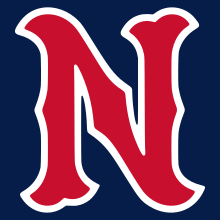
The Nashville Sounds are a Minor League Baseball team of the International League and the Triple-A affiliate of the Milwaukee Brewers. They are located in Nashville, Tennessee, and are named for the city's association with the music industry, specifically the "Nashville sound", a subgenre of country music which originated in the city in the mid-1950s. The team plays their home games at First Horizon Park, which opened in 2015 on the site of the historic Sulphur Dell ballpark. The Sounds previously played at Herschel Greer Stadium from its opening in 1978 until the end of the 2014 season. They are the oldest active professional sports franchise in Nashville.
Established as an expansion team of the Double-A Southern League in 1978, the Sounds led all of Minor League Baseball in attendance in their inaugural season and continued to draw the Southern League's largest crowds in each of their seven years as members. On the field, the team won six consecutive second-half division titles from 1979 to 1984 and won the Southern League championship twice: in 1979 as the Double-A affiliate of the Cincinnati Reds and again in 1982 as the Double-A affiliate of the New York Yankees. (Full article...) -
Image 12
Osborne Earl Smith (born December 26, 1954) is an American former professional baseball player. Nicknamed "The Wizard of Oz", Smith played shortstop for the San Diego Padres and St. Louis Cardinals in Major League Baseball, winning the National League Gold Glove Award for defensive play at shortstop for 13 consecutive seasons. A 15-time All-Star, Smith accumulated 2,460 hits and 580 stolen bases during his career, and won the National League Silver Slugger Award as the best hitter at shortstop in 1987. He was elected to the Baseball Hall of Fame in his first year of eligibility in 2002. He was also elected to the St. Louis Cardinals Hall of Fame in the inaugural class of 2014.
Smith was born in Mobile, Alabama; his family moved to Watts, Los Angeles, when he was six years old. While participating in childhood athletic activities, Smith possessed quick reflexes; he went on to play baseball at Locke High School in Los Angeles, then at California Polytechnic State University, San Luis Obispo. Drafted as an amateur player by the Padres, Smith made his major league debut in 1978. He quickly established himself as an outstanding fielder, and later became known for performing backflips on special occasions while taking his position at the beginning of a game. Smith won his first Gold Glove Award in 1980 and made his first All-Star Game appearance in 1981. (Full article...) -
Image 13
Stephen Crane (November 1, 1871 – June 5, 1900) was an American poet, novelist, and short story writer. Prolific throughout his short life, he wrote notable works in the Realist tradition as well as early examples of American Naturalism and Impressionism. He is recognized by modern critics as one of the most innovative writers of his generation.
The ninth surviving child of Methodist parents, Crane began writing at the age of four and had several articles published by 16. Having little interest in university studies though he was active in a fraternity, he left Syracuse University in 1891 to work as a reporter and writer. Crane's first novel was the 1893 Bowery tale Maggie: A Girl of the Streets, generally considered by critics to be the first work of American literary Naturalism. He won international acclaim for his Civil War novel The Red Badge of Courage (1895), considered a masterpiece by different critics and writers. (Full article...) -
Image 14Disco Demolition Night was a Major League Baseball (MLB) promotion on Thursday, July 12, 1979, at Comiskey Park in Chicago, Illinois, that ended in a riot. At the climax of the event, a crate filled with disco records was blown up on the field between games of the twi-night doubleheader between the Chicago White Sox and the Detroit Tigers. Many had come to see the explosion rather than the games and rushed onto the field after the detonation. The playing field was so damaged by the explosion and by the rioters that the White Sox were required to forfeit the second game to the Tigers.
In the late 1970s, dance-oriented disco was the most popular music genre in the United States, particularly after being featured in hit films such as Saturday Night Fever (1977). However, disco sparked a major backlash from rock music fans—an opposition prominent enough that the White Sox, seeking to fill seats at Comiskey Park during a lackluster season, engaged Chicago shock jock and anti-disco campaigner Steve Dahl for the promotion at the July 12 doubleheader. Dahl's sponsoring radio station was WLUP (97.9 FM, now WCKL), so admission was discounted to 98 cents for attendees who turned in a disco record; between games, Dahl was to destroy the collected vinyl in an explosion. (Full article...) -
Image 15
Albert Benjamin "Happy" Chandler Sr. (July 14, 1898 – June 15, 1991) was an American politician from Kentucky. He represented Kentucky in the U.S. Senate and served as its 44th and 49th governor. Aside from his political positions, he also served as the second commissioner of baseball from 1945 to 1951 and was inducted into the Baseball Hall of Fame in 1982. His grandson, Ben Chandler, later served as congressman for Kentucky's Sixth District.
A multi-sport athlete during his college days at Transylvania College, Chandler briefly considered a career in professional baseball before deciding to pursue a law degree. After graduation, he entered politics and was elected as a Democrat to the Kentucky Senate in 1929. Two years later, he was elected lieutenant governor, serving under Governor Ruby Laffoon. Chandler and Laffoon disagreed on the issue of instituting a state sales tax and when Chandler, the presiding officer in the state senate, worked to block the legislation, Laffoon's allies in the General Assembly stripped him of many of his statutory powers. The tax then passed by a narrow margin. Knowing that Laffoon would try to select his own successor at the Democratic nominating convention, Chandler waited until Laffoon left the state—leaving Chandler as acting governor—and called the legislature into session to enact a mandatory primary election bill. The bill passed, and in the ensuing primary, Chandler defeated Laffoon's choice, Thomas Rhea. He then went on to defeat Republican King Swope by the largest margin of victory for a Kentucky gubernatorial race at that time. As governor, Chandler oversaw the repeal of the sales tax, replacing the lost revenue with new excise taxes and the state's first income tax. He also enacted a major reorganization of state government, realizing significant savings for the state. He used these savings to pay off the state debt and improve the state's education and transportation systems. (Full article...)
General images - load new batch
-
Image 1Pick-off attempt on runner (in red) at first base (from Baseball rules)
-
Image 2A first baseman receives a pickoff throw, as the runner dives back to first base. (from Baseball)
-
Image 3The typical motion of a right-handed pitcher (from Baseball rules)
-
Image 4Diagram of a baseball field Diamond may refer to the square area defined by the four bases or to the entire playing field. The dimensions given are for professional and professional-style games. Children often play on smaller fields. (from Baseball)
-
Image 5Alexander Cartwright, father of modern baseball (from History of baseball)
-
Image 6Cover of Official Base Ball Rules, 1921 edition, used by the American League and National League (from Baseball rules)
-
Image 7A well-worn baseball (from Baseball)
-
Image 8A New York Yankees batter (Andruw Jones) and a Boston Red Sox catcher at Fenway Park (from Baseball)
-
Image 9The American Tobacco Company's line of baseball cards featured shortstop Honus Wagner of the Pittsburgh Pirates from 1909 to 1911. In 2007, the card shown here sold for $2.8 million. (from Baseball)
-
Image 11Cy Young—the holder of many major league career marks, including wins and innings pitched, as well as losses—in 1908. MLB's annual awards for the best pitcher in each league are named for Young. (from Baseball)
-
Image 13Two players on the baseball team of Tokyo, Japan's Waseda University in 1921 (from Baseball)
-
Image 14Rickey Henderson—the major leagues' all-time leader in runs and stolen bases—stealing third base in a 1988 game (from Baseball)
-
Image 15Baseball games sometimes end in a walk-off home run, with the batting team usually gathering at home plate to celebrate the scoring of the winning run(s). (from Baseball rules)
-
Image 16The strike zone, which determines the outcome of most pitches, varies in vertical length depending on the batter's typical height while swinging. (from Baseball rules)
-
Image 17In May 2010, the Philadelphia Phillies' Roy Halladay pitched the 20th major league perfect game. That October, he pitched only the second no-hitter in MLB postseason history. (from History of baseball)
-
Image 18Sadaharu Oh managing the Japan national team in the 2006 World Baseball Classic. Playing for the Central League's Yomiuri Giants (1959–80), Oh set the professional world record for home runs. (from Baseball)
-
Image 19Baserunners generally stand a short distance away from their base between pitches, preparing themselves to either go back or steal the next base. (from Baseball rules)
-
Image 20Pesäpallo, a Finnish variation of baseball, was invented by Lauri "Tahko" Pihkala in the 1920s, and after that, it has changed with the times and grown in popularity. Picture of Pesäpallo match in 1958 in Jyväskylä, Finland. (from Baseball)
-
Image 21The strike zone determines the result of most pitches, and varies in vertical length for each batter. (from Baseball)
-
Image 222013 World Baseball Classic championship match between the Dominican Republic and Puerto Rico, March 20, 2013 (from Baseball)
-
Image 24Pitchers are generally substituted during mound visits (team gatherings at the pitcher's mound). (from Baseball rules)
-
Image 25The NL champion New York Giants baseball team, 1913. Fred Merkle, sixth in line, had committed a baserunning gaffe in a crucial 1908 game that became famous as Merkle's Boner. (from History of baseball)
-
Image 261906 World Series, infielders playing "in" for the expected bunt and the possible play at the plate with the bases loaded (from Baseball rules)
-
Image 27Jackie Robinson in 1945, with the era's Kansas City Royals, a barnstorming squad associated with the Negro American League's Kansas City Monarchs (from History of baseball)
-
Image 28Sadaharu Oh managing the Japan national team in the 2006 World Baseball Classic. Playing for the Central League's Yomiuri Giants (1959–80), Oh set the professional world record for home runs with 868. (from History of baseball)
-
Image 30By the 1860s Civil War, baseball (bottom) had overtaken its fellow bat-and-ball sport cricket (top) in popularity within the United States. (from History of baseball)
-
Image 33Jackie Robinson in 1945, with the era's Kansas City Royals, a barnstorming squad associated with the Negro American League's Kansas City Monarchs (from Baseball)
-
Image 35The standard fielding positions (from Baseball rules)
-
Image 36Fenway Park, home of the Boston Red Sox. The Green Monster is visible beyond the playing field on the left. (from Baseball)
-
Image 37Defensive positions on a baseball field, with abbreviations and scorekeeper's position numbers (not uniform numbers) (from Baseball)
-
Image 39An Afghan girl playing baseball in August 2002 (from Baseball)
-
Image 41A game from the Cantigas de Santa Maria, c. 1280, involving tossing a ball, hitting it with a stick and competing with others to catch it (from History of baseball)
-
Image 42A runner sliding into home plate and scoring. (from Baseball)
-
Image 43A batter follows through after swinging at a pitched ball. (from Baseball rules)
-
Image 44A pitcher handing off the ball after being taken out of the game during a mound meeting. (from Baseball)
-
Image 45Japanese-Americans spectating a World War II-era game while in an internment camp. America's ties to immigrants and to Japan have been deeply shaped by a shared baseball heritage. (from History of baseball)
 Good articles - load new batch
Good articles - load new batch
-
Image 1Addie Joss in 1902
The Addie Joss Benefit Game was an exhibition baseball game played between the Cleveland Naps of the American League and an all-star team composed of players from the league's other teams at League Park in Cleveland, Ohio, on July 24, 1911. The game was planned as a benefit for the family of Addie Joss, a pitcher for the Naps who died in April. The all-stars defeated the Naps, 5–3, and the game raised $12,914 for the Joss family ($422,288 in current dollar terms).
Following Joss's death, Cleveland's management announced their plans to put on a benefit for his widow and two young children. Star players from other teams volunteered to form an all-star team to play against the Naps. Paid attendance was 15,272, and many players and team owners contributed money to the Joss family as well. The benefit game preceded the creation of the Major League Baseball All-Star Game, first contested in 1933, which raises money for the players' pension fund. (Full article...) -
Image 2Waldis Joaquín de la Cruz (born December 25, 1986) is a Dominican professional baseball pitcher. He played for the San Francisco Giants of Major League Baseball (MLB) from 2009 through 2011. Joaquín throws three pitches: a fastball, a slider, and a changeup.
Signed by the Giants in 2003, Joaquín reached the major leagues in 2009 and appeared in 10 games, which would be his highest total in an MLB season. Part of the Opening Day roster in 2010, he pitched in four games during San Francisco's World Series championship season. The Chicago White Sox attempted to claim him off waivers in the offseason, but he refused to report to them, nullifying the waiver claim. Returning to the Giants in 2011, he had five games for them in September and received his lone MLB decision, a win. (Full article...) -
Image 3
Richard Benjamin Ferrell (October 12, 1905 – July 27, 1995) was an American professional baseball player, coach, scout, and executive. He played for 18 seasons as a catcher in Major League Baseball (MLB) from 1929 through 1947 for the St. Louis Browns, Boston Red Sox, and Washington Senators. His brother, Wes Ferrell, was a major league pitcher for 15 seasons, and they were teammates from 1933 through part of 1938 on the Red Sox and Senators. Following his three seasons in minor league baseball, he appealed to the Commissioner of Baseball to become a free agent, claiming that he was being held in the minors though he deserved promotion. The Commissioner agreed, and he was granted free agency; he signed with the St. Louis Browns.
Ferrell was regarded as one of the best catchers in baseball during the 1930s and early 1940s. While playing for the Red Sox in 1933, he and his brother Wes were selected to play for the American League (AL) team in the inaugural 1933 Major League Baseball All-Star Game held on July 6, 1933. His 1,806 games played as a catcher set an AL longevity record which stood for more than 40 years. A seven-time All-Star, Ferrell was elected to the Baseball Hall of Fame in 1984 by the Veterans Committee. After his playing career, he became a coach with the Senators, and later a scout and general manager with the Detroit Tigers. He died in July 1995 at the age of 89. (Full article...) -
Image 4

The Philadelphia Phillies' 2014 season was the 132nd in the history of the franchise. After a disappointing 2013, the Phillies entered the offseason with a strategy to reload rather than rebuild; they did not want to relinquish the opportunity to do well in 2014 in hopes of being competitive down the road. Commensurate with this strategy, among their key acquisitions were right fielder Marlon Byrd and starting pitcher A. J. Burnett. The Phillies began the season with new coaches (as Ryne Sandberg entered his first season as manager after taking over on an interim basis in August 2013) and new broadcasters: Jamie Moyer and Matt Stairs, two members of the 2008 World Series squad, replaced Chris Wheeler and Gary Matthews as analysts on Comcast SportsNet Philadelphia.
After offseason headlines indicated a tenuous relationship between Sandberg and shortstop Jimmy Rollins and controversy about draft picks who did not sign with the team, the season began auspiciously with an opening-day win. However, the Phillies then lost their next two games. April continued in that fashion; the team played .500 ball in their first 26 games, exceeding expectations. One commentator called them "pleasantly mediocre", despite a horrific performance from the bullpen. May was a frustrating month for the Phillies; failing to win games they were in a position to win, they posted an 11–16 record and a .230 team batting average (the worst in the National League). June was almost as bad; although the team had 12 wins and 17 losses, the bullpen improved to one of the best in the NL. In the 2014 Major League Baseball draft that month the Phillies selected Aaron Nola as their first-round pick, encouraging optimism from fans and the media. Although the Phillies began July at the bottom of the National League East Division, they amassed a five-game winning streak shortly before the All-Star break. This moved them to within nine games of .500, but they lost the last two games and had a 42–53 record at the break. (Full article...) -
Image 5
Juan Cespedes Uribe Tena (born March 22, 1979) is a Dominican former professional baseball infielder. He played shortstop, third base and second base during his career in Major League Baseball (MLB) for the Colorado Rockies, Chicago White Sox, San Francisco Giants, Los Angeles Dodgers, Atlanta Braves, New York Mets and Cleveland Indians. He bats and throws right-handed.
Uribe began his professional career in 1997 when he was signed by the Colorado Rockies. After advancing through the minors, he made his MLB debut with the Rockies in 2001. He became their shortstop in 2001 and spent all of 2002 in that capacity. He missed part of 2003 with an injury and was traded to the Chicago White Sox following the season. After one season as a utility player, Uribe became the starting shortstop for the White Sox in 2005; he held that position for the next three years. While Uribe was with the White Sox, the team won the 2005 World Series against the Houston Astros. Uribe hit 21 home runs in 2006 but had a low on-base percentage. He hit 20 home runs in 2007 but had a low batting average with runners in scoring position (RISP). In 2008, Uribe lost his starting shortstop role to Orlando Cabrera and shifted to the starter at second, but then lost that job to rookie Alexei Ramírez. He eventually ended the season as the team's third baseman due to an injury to Joe Crede. (Full article...) -
Image 6Moneyball is a 2011 American biographical sports drama film directed by Bennett Miller with a script by Steven Zaillian and Aaron Sorkin from a story by Stan Chervin. The film is based on the 2003 nonfiction book, Moneyball: The Art of Winning an Unfair Game by Michael Lewis. The book is an account of the Oakland Athletics baseball team's 2002 season and their general manager Billy Beane's attempts to assemble a competitive team with half (or even a third) as much money as his rivals. In the film, Beane and his deputy Peter Brand scour the major leagues for undervalued talent by taking a sophisticated sabermetric approach to scouting and analyzing players, triggering skepticism and resentment within the baseball community.
Columbia Pictures bought the rights to Lewis's book in 2004, hiring Chervin to write the screenplay. David Frankel was initially set to direct with Zaillian now writing the screenplay, but was soon replaced by Steven Soderbergh, who planned to make the film in a semi-documentary style featuring interviews from real athletes, and having the real players and coaches on the team portray themselves. But before its July 2009 filming start, the film was put in turnaround due to creative differences between Soderbergh and Sony over a last-minute script rewrite. Soderbergh exited, and Miller was hired to direct, with Pitt becoming a producer and Sorkin hired for rewrites. Filming began in July 2010 at various stadiums such as Dodger Stadium and Oakland Coliseum. (Full article...) -
Image 7
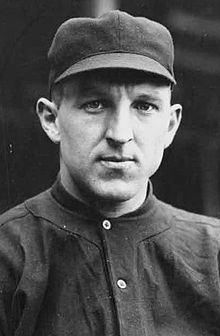
Charles Lincoln "Buck" Herzog (July 9, 1885 – September 4, 1953) was an American infielder and manager in Major League Baseball who played for four National League clubs between 1908 and 1920: the New York Giants, the Boston Braves, the Cincinnati Reds, and the Chicago Cubs. His flexibility sets him apart from other major leaguers, as he demonstrated great skill as a second baseman, shortstop, and third baseman.
Born in Baltimore, Maryland, Herzog grew up on a farm in nearby Ridgely. After attending the Maryland Agricultural College, he played one season in the minor leagues before the Giants selected him in the Rule 5 Draft. Herzog batted .300 as a rookie but struggled in 1909 and was traded to Boston before 1910. He cemented himself as an everyday player over the next two years, then was reacquired by the Giants in 1911, with whom he would reach three straight World Series. He struggled to hit in the 1911 World Series but set a record that would stand for over 50 years with 12 hits in the 1912 World Series, though the Giants lost all three of the series. Traded to the Reds before the 1914 season, he served as a player-manager for the Reds through the first half of the 1916 season, though the team had a losing record in each of those years. The Giants reacquired him halfway through 1916, naming him the team captain. After a famous fight with Ty Cobb during 1917 spring training, he played in his fourth and final World Series, though he made a key error in Game 5 as the Giants were defeated in six games. Herzog spent 1918 with Boston, was traded to Chicago in the middle of 1919, and played one last year with the Cubs in 1920, a season that saw his reputation tarnished by unsubstantiated accusations of gambling on baseball games. (Full article...) -
Image 8
Napoléon "Nap" Lajoie (/ˈlæʒəweɪ/; September 5, 1874 – February 7, 1959), also known as Larry Lajoie, was an American professional baseball second baseman who played 21 seasons in Major League Baseball (MLB). Nicknamed "the Frenchman", he represented both Philadelphia franchises and the Cleveland Naps, the latter of which he became the namesake of, and from 1905 through 1909, the player-manager.
Lajoie was signed to the Philadelphia Phillies of the National League (NL) in 1896. By the beginning of the 20th century, however, the upstart American League (AL) was looking to rival the supremacy of the NL and in 1901, Lajoie and dozens of former National League players joined the American League. National League clubs contested the legality of contracts signed by players who jumped to the other league, but eventually Lajoie was allowed to play for Connie Mack's Philadelphia Athletics. During the season, Lajoie set the all-time American League single-season mark for the highest batting average (.426). One year later, Lajoie went to the Cleveland Bronchos, where he would play until the 1915 season, when he returned to play for Mack and the Athletics. While with Cleveland, Lajoie's popularity led to locals electing to change the club's team name from Bronchos to Napoleons ("Naps" for short), which remained until after Lajoie departed Cleveland and the name was changed to Indians (the team's name until 2021). (Full article...) -
Image 9

Adam Joseph DeBus, Jr. (October 7, 1892 – May 13, 1977) was a German American professional baseball player whose career spanned three seasons, one of which was spent with the Major League Baseball (MLB) Pittsburgh Pirates (1917). Over his MLB career, DeBus, an infielder, compiled a .229 batting average with nine runs scored, 30 hits, five doubles, four triples, seven runs batted in (RBIs) and two stolen bases in 38 games played. Originally, Debus signed with the MLB St. Louis Cardinals out of the Northern League, but his contract was waived after never making an appearance. He then signed with the Pittsburgh Pirates and made his MLB debut on July 14, 1917, against the Brooklyn Robins. During his career, DeBus weighed 150 pounds (68 kg) and stood at 5 feet 11 inches (180 cm). He batted and threw right-handed. (Full article...) -
Image 10Amanda E. Clement (March 20, 1888 – July 20, 1971) was an American baseball umpire who was the first woman paid to referee a game, and may have also been the first woman to referee a high school basketball game. Clement served as an umpire on a regular basis for six years, and served occasionally for several decades afterwards. An accomplished athlete in multiple disciplines, Clement competed in baseball, basketball, track, gymnastics, and tennis, and has been attributed world records in shot put, sprinting, hurdling, and baseball. (Full article...)
-
Image 11Collins with the St. Louis Browns, 1922
Tharon Leslie "Pat" Collins (September 13, 1896 – May 20, 1960) was an American baseball catcher who played ten seasons in Major League Baseball (MLB). He played for the St. Louis Browns, New York Yankees and Boston Braves from 1919 to 1929. Collins batted and threw right-handed and also played five games at first base.
Collins played minor league baseball for the Joplin Miners until 1919, when he signed with the Browns. After spending six seasons with the organization, Collins spent a one-year sojourn in the minor leagues before he was traded to the Yankees, where he spent the next three years and played in the famous 1927 Murderers' Row lineup. At the conclusion of the 1928 season, he was traded to the Braves, with whom he played his last major league game on May 23, 1929. A two-time World Series champion, he is famous for being the only major league player to pinch hit and pinch run in the same game. (Full article...) -
Image 12Bruce Eugene Kison (February 18, 1950 – June 2, 2018) was an American professional baseball pitcher, who played in Major League Baseball (MLB) for the Pittsburgh Pirates (1971–79), California Angels (1980–84) and Boston Red Sox (1985). Kison won two World Series championships with the Pirates, both over the Baltimore Orioles, and is perhaps best remembered for throwing 6+1⁄3 scoreless innings of relief to win Game 4 of the 1971 World Series. He batted and threw right-handed.
Kison grew up in Pasco, Washington, and was drafted by the Pirates in the 14th round of the 1968 Major League Baseball draft. He reached the major leagues in 1971 and relieved Luke Walker in the first inning of Game 4 of the World Series, throwing 6+1⁄3 scoreless innings as he enabled the Pirates to come from behind to win the game, and ultimately the Series. Bothered by a sore shoulder the next two years, Kison adjusted his delivery in the 1973–74 offseason, becoming a full-time starter by the middle of 1974. In 1976, he set career highs in wins (14) and earned run average (ERA) (3.08). He had a disappointing 1977 season, partly because of hangnail problems, and in 1978, he was moved back to the bullpen to start the year. He regained his rotation spot halfway through the season, though, and proved an important member of the Pirates' rotation once again in 1979, winning the season's final game to send the Pirates to the playoffs. He struggled in his only start of the World Series but won his second World Series ring as the Pirates defeated the Orioles again. (Full article...) -
Image 13

Robert Vavasour Ferguson (January 31, 1845 – May 3, 1894) was an American infielder, league official, manager and umpire in the early days of baseball, playing both before and after baseball became a professional sport. In addition to playing and managing, he served as president of the National Association of Professional Base Ball Players from 1872 through 1875, the sport's first entirely professional league. His character and unquestioned honesty were highly regarded during a period in baseball history where the game's reputation was badly damaged by gamblers and rowdy behavior by players and fans. However, his bad temper and stubbornness were traits that created trouble for him at times during his career, and caused him to be disliked by many. His nickname, "Death to Flying Things", was derived from his greatness as a defensive player. (Full article...) -
Image 14

Michael Dominick Rocco (March 2, 1916 – June 1, 1997) was an American professional baseball player. A first baseman, Rocco played in Major League Baseball (MLB) for four seasons in the American League with the Cleveland Indians. In 440 career games, Rocco recorded a batting average of .258 and accumulated 30 home runs and 186 runs batted in (RBI).
A native of Minnesota, Rocco began playing professional baseball in 1935, and played in the minor leagues for the next eight years. In June 1943, he was promoted to the Cleveland Indians, and served as the team's everyday first baseman during the war years. After the war ended, Rocco played one more season with the Indians in 1946, then returned to the minor leagues. There, he played primarily in the Pacific Coast League (PCL) until 1952, retiring after attempting to play amateur baseball in Minnesota and being ruled ineligible. (Full article...) -
Image 15
Sergio Francisco Romo (born March 4, 1983) is an American former professional baseball pitcher. He played in Major League Baseball (MLB) for the San Francisco Giants, Los Angeles Dodgers, Tampa Bay Rays, Miami Marlins, Minnesota Twins, Oakland Athletics, Seattle Mariners, and Toronto Blue Jays. A right-hander who served as a closer during his career, his main pitch was his slider.
Born in Brawley, California, Romo grew up a Dodgers fan. He attended four colleges, getting drafted in the 28th round of the 2005 draft by the Giants. He reached the major leagues in 2008 and appeared in 45 games for the Giants in 2009. In 2010, he became the setup man for Giants closer Brian Wilson as the Giants won the 2010 World Series. He posted a 1.50 earned run average (ERA) in 2011, then became the closer for the Giants in 2012, recording three saves during the 2012 World Series as the Giants won the title. He was an All-Star in 2013, and though he lost the closer role the next year, he won his third World Series ring as the Giants defeated the Kansas City Royals in the 2014 World Series. (Full article...)
Did you know (auto-generated) - load new batch

- ... that one Baltimore Orioles player compared the 2024 Major League Baseball jerseys to knockoffs from TJ Maxx?
- ... that Amanda Asay was the longest-serving member of the Canadian women's baseball team when she died at 33, having played on the team for sixteen years?
- ... that Helene Hathaway Britton, the first woman to own a Major League Baseball team, was unsuccessfully pressured by other club owners to sell the team?
- ... that after getting drunk and verbally abusing Cap Anson at a baseball game during his off day, Charlie Bartson was released from the Chicago Pirates?
- ... that Cam Booser retired from baseball to work as a carpenter in 2017 and made it to Major League Baseball in 2024?
- ... that Domingo Germán was booed off the pitcher's mound in the game prior to his perfect game?
- ... that Harry Booth played for, captained, and coached the Saint Joseph's Hawks baseball and men's basketball teams?
- ... that Kelsie Whitmore was part of the first all-female battery in a professional baseball league since the All-American Girls Professional Baseball League?
Quotes
| I bleed Dodger blue and when I die, I'm going to the big Dodger in the sky. |
 Featured lists - load new batch
Featured lists - load new batch
-
Image 1
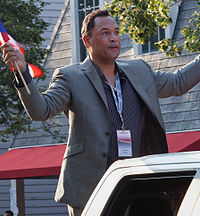
Roberto Alomar leads all second basemen with 10 Gold Glove Award wins.
The Gold Glove Award is the award given annually to the Major League Baseball players judged to have exhibited superior individual fielding performances at each fielding position in both the National League (NL) and the American League (AL), as voted by the managers and coaches in each league. Managers are not permitted to vote for their own players. Eighteen Gold Gloves are awarded each year (with the exception of 1957, 1985, 2007 and 2018), one at each of the nine positions in each league. In 1957, the baseball glove manufacturer Rawlings created the Gold Glove Award to commemorate the best fielding performance at each position. The award was created from a glove made from gold lamé-tanned leather and affixed to a walnut base. Initially, only one Gold Glove per position was awarded to the top fielder at each position in the entire league; however, separate awards were given for the National and American Leagues beginning in 1958.
Roberto Alomar leads second basemen in wins; he won 10 Gold Gloves in 11 years with three different American League teams. Ryne Sandberg has the second-highest total overall; his nine awards, all won with the Chicago Cubs, are the most by a National League player. Bill Mazeroski and Frank White are tied for the third-highest total, with eight wins. Mazeroski's were won with the Pittsburgh Pirates, and White won his with the Kansas City Royals. Joe Morgan and Bobby Richardson each won five Gold Glove Awards, and four-time winners include Craig Biggio (who won after converting to second base from catcher), Bret Boone, Bobby Grich, Orlando Hudson, Dustin Pedroia, and Brandon Phillips. Hall of Famers who won Gold Gloves at second base include Alomar, Sandberg, Mazeroski, Morgan, Biggio and Nellie Fox. (Full article...) -
Image 2

Ken Griffey Jr., the 1987 first overall draft pick
The first-year player draft, also known as the Rule 4 Draft, is the primary mechanism for assigning amateur baseball players from high schools, colleges, and other amateur baseball clubs to Major League Baseball (MLB) teams. Unlike most professional sports, MLB does not permit the trading of draft picks. Since 2023, the first six selections are determined by a lottery; the previous season's standings determine the remaining selections. If two teams have identical records, the team with the worse record in the previous season will receive the higher pick. In addition, teams that lost free agents in the previous off-season may be awarded "compensatory" picks. The first draft took place in 1965; it was introduced to prevent richer teams from negotiating wealthier contracts with top-level prospects and therefore, monopolizing the player market. Originally, three drafts were held each year. The first draft took place in June and involved high-school graduates and college seniors who had just finished their seasons. The second draft took place in January for high school and college players who had graduated in December. The third draft took place in August and was for players who participated in American amateur summer leagues. The August draft was eliminated after two years, and the January draft lasted until 1986.
In 1965, Rick Monday became MLB's first draft pick after being selected by the Kansas City Athletics. Travis Bazzana is the most recent first overall pick; he was drafted by the Cleveland Guardians in 2024. Overall, 23 of the 50 picks before 2015 have participated in the All-Star Game, and four (Bob Horner, Darryl Strawberry, Bryce Harper, and Carlos Correa) have won the Rookie of the Year Award. Twenty-five of the fifty picks before 2015 have been drafted from high schools, one has been drafted out of the Independent American Association, and the others were drafted from universities. To date, Arizona State University, Vanderbilt University, Louisiana State University, and Oregon State University are the only schools from which multiple number-one overall draft picks have been chosen. No first overall pick was inducted into the National Baseball Hall of Fame until 2016, when Ken Griffey Jr. was inducted with a record 99.3 percent of votes cast. Griffey has since been joined by three other top picks: Chipper Jones, inducted in 2018; Harold Baines, elected in December 2018 and inducted in July 2019, and Joe Mauer, inducted in 2024. (Full article...) -
Image 3In its 123-year history, the Baltimore Orioles baseball franchise of Major League Baseball's American League has employed 42 managers. The duties of the team manager include team strategy and leadership on and off the field. Of those 42 managers, 12 have been "player-managers"; specifically, they managed the team while still being signed as a player. Since 1992, the team has played its home games at Oriole Park at Camden Yards.
The Baltimore franchise began operations in Milwaukee, Wisconsin, as the Brewers (not to be confused with the current National League team of the same name) in 1901. After one season in Wisconsin under manager and Hall of Famer Hugh Duffy, the franchise moved south to St. Louis, Missouri, adopting the St. Louis Browns name and hiring a new manager, Jimmy McAleer. The Browns remained in Missouri until the end of the 1953 season, when Major League Baseball's owners elected to move the franchise to Baltimore, Maryland, where they were renamed the Orioles, after Maryland's state bird. (Full article...) -
Image 4

Barry Larkin is the Silver Slugger Award leader among shortstops, with nine wins.
The Silver Slugger Award is awarded annually to the best offensive player at each position in both the American League (AL) and the National League (NL), as determined by the coaches and managers of Major League Baseball (MLB). These voters consider several offensive categories in selecting the winners, including batting average, slugging percentage and on-base percentage, in addition to "coaches' and managers' general impressions of a player's overall offensive value." Managers and coaches are not permitted to vote for players on their own team. The Silver Slugger was first awarded in 1980 and is given by Hillerich & Bradsby, the manufacturer of Louisville Slugger bats. The award is a bat-shaped trophy, 3 feet (91 cm) tall, engraved with the names of each of the winners from the league and plated with sterling silver.
Among shortstops, Barry Larkin is the leader in Silver Slugger Awards, with nine wins between 1988 and 1999, including five consecutive awards (1988–1992). Larkin is fourth all-time in Silver Slugger wins among all positions, behind outfielder Barry Bonds, catcher Mike Piazza and third baseman Alex Rodriguez, who won his first seven awards at shortstop before a position change. Hall of Famer Cal Ripken Jr. won eight Silver Sluggers as a shortstop from 1983 to 1993. Derek Jeter (2006–2009; 2012) and Xander Bogaerts (2015–2016; 2019; 2021–2022) each won five Silver Sluggers as a shortstop, while Ian Desmond (2012–2014), Alan Trammell (1987–1988, 1990), and Édgar Rentería (2000; 2002–2003) won three. Francisco Lindor (2017–2018; 2023) and Corey Seager (2016–2017; 2023) each won three Silver Slugger Awards at shortstop across two different leagues. (Full article...) -
Image 5

Barry Bonds has won 12 Silver Slugger Awards, the most of any player at any position.
The Silver Slugger Award is awarded annually to the best offensive player at each position in both the American League (AL) and the National League (NL), as determined by the coaches and managers of Major League Baseball (MLB). These voters consider several offensive categories in selecting the winners, including batting average, slugging percentage, and on-base percentage, in addition to "coaches' and managers' general impressions of a player's overall offensive value". Managers and coaches are not permitted to vote for players on their own team. The Silver Slugger was first awarded in 1980 and is given by Hillerich & Bradsby, the manufacturer of Louisville Slugger bats. The award is a bat-shaped trophy, 3 feet (91 cm) tall, engraved with the names of each of the winners from the league and plated with sterling silver.
As with the Rawlings Gold Glove Award, the prize is presented to outfielders irrespective of their specific position. This means that it is possible for three left fielders, or any other combination of outfielders, to win the award in the same year, rather than one left fielder, one center fielder, and one right fielder. It is also possible for outfield teammates to win the award in the same season, which has happened eight times since 1980. (Full article...) -
Image 6
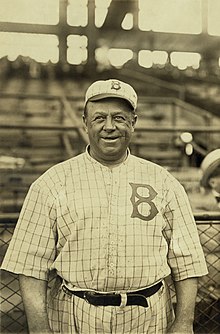
In baseball, a hit is credited to a batter when he reaches first base – or any subsequent base – safely after hitting a fair ball, without the benefit of an error or a fielder's choice. One hundred nineteen different players have recorded at least six hits in a single nine-inning Major League Baseball game. Five players have accomplished the feat more than once in their career; no player has ever recorded more than seven hits in a nine-inning game. Davy Force was the first player to collect six hits in a single game, doing so for the Philadelphia Athletics against the Chicago White Stockings on June 27, 1876.
These games have resulted in other single-game MLB records being set in connection with the prodigious offensive performance. Shawn Green, for example, established a new major league record with 19 total bases and finished with a total of five extra-base hits, tying a National League record that was also achieved by Larry Twitchell during the latter's six-hit game. Four of Green's six hits were home runs, equaling the record for most home runs in one game. Jim Bottomley, Walker Cooper, Anthony Rendon, and Wilbert Robinson hit 10 or more runs batted in (RBI) to complement their six hits. Robinson proceeded to collect a seventh hit and an eleventh RBI to set single-game records in both categories. Although his record of 11 RBIs has since been broken, Robinson's seven hits in a nine-inning game has been matched only by Rennie Stennett. (Full article...) -
Image 7

Roy Halladay (1995) is the only Blue Jays' first-round pick to be inducted into the Baseball Hall of Fame, and to win a Cy Young Award with the team.
The Toronto Blue Jays are a Major League Baseball (MLB) franchise based in Toronto, Ontario, Canada. They play in the American League East division. Since the Blue Jays' entrance into the league in 1977, the Blue Jays have selected 72 players in the first round. Officially known as the "First-Year Player Draft", the Rule 4 draft is MLB's primary mechanism for assigning amateur players from high schools, colleges, and other amateur clubs to its teams. The draft order is determined based on the previous season's standings, with the team possessing the worst record receiving the first pick. In addition, teams which lost free agents in the previous off-season may be awarded compensatory or supplementary picks. The First-Year Player Draft is unrelated to the 1976 expansion draft in which the Blue Jays initially filled their roster.
Of the 72 players picked in the first round by Toronto, 35 have been pitchers, the most of any position; 26 of them were right-handed, while nine were left-handed. 14 shortstops, 12 outfielders, four catchers and third basemen, and three first basemen have also been selected. The team has never drafted a player at second base in the first round. 38 players were drafted out of high school, while 31 came from four-year college programs and two from junior colleges. They have also drafted two players from Puerto Rico: Alex Ríos (1999) and Miguel Negrón (2000). (Full article...) -
Image 8

Nolan Ryan is Major League Baseball's all-time strikeout leader at 5,714.
In Major League Baseball (MLB), the 3,000 strikeout club is the group of 19 pitchers who have struck out 3,000 or more batters in their careers. Walter Johnson became the first member in 1923, and was the only one until Bob Gibson joined in 1974. The most recent addition is Max Scherzer, who joined on September 12, 2021. The group includes three left-handed pitchers: CC Sabathia, Steve Carlton, and Randy Johnson. Randy Johnson reached the mark with the fewest games pitched and innings pitched. The Minnesota Twins were the first of four franchises to see multiple pitchers record their 3,000th strikeout: Walter Johnson (while the franchise was called the Washington Senators) in 1923 and Bert Blyleven in 1986. The other teams with multiple members are the Chicago Cubs (Ferguson Jenkins and Greg Maddux), the New York Yankees (Phil Niekro and Sabathia), and the Houston Astros (Nolan Ryan and Justin Verlander). César Gerónimo is the only player struck out by two pitchers for their 3,000th strikeout: Gibson in 1974 and Ryan in 1980. Ten 3,000-strikeout pitchers are also members of the 300-win club. Seven members were named to the All-Century Team, a list of MLB's best 100 players; fans later elected four of them as starters. Thirteen members of the club also won a Cy Young Award in their careers.
The club is considered to almost be a guarantee of entry into the National Baseball Hall of Fame. Fourteen members of the 3,000-strikeout club have been elected to the Hall, most recently Randy Johnson, Pedro Martínez, and John Smoltz, all voted in during the 2015 balloting. Three more members - Sabathia, Scherzer, and Verlander - are not yet eligible for election, being neither dead for six months nor retired for five seasons. The remaining two, Roger Clemens and Curt Schilling, made their first appearances on the ballot for the 2013 elections and received about half of the total votes needed for induction before falling off the ballot in 2022. Clemens' future election is seen as uncertain because of his alleged links to use of performance-enhancing drugs. (Full article...) -
Image 9

Greg Maddux has won 18 Gold Gloves, the most in Major League Baseball history.
The Gold Glove Award is the award given annually to the Major League Baseball players judged to have exhibited superior individual fielding performances at each fielding position in both the National League (NL) and the American League (AL), as voted by the managers and coaches in each league. Managers are not permitted to vote for their own players. Eighteen Gold Gloves are awarded each year (with the exception of 1957, 1985, 2007 and 2018), one at each of the nine positions in each league. In 1957, the baseball glove manufacturer Rawlings created the Gold Glove Award to commemorate the best fielding performance at each position. The award was created from a glove made from gold lamé-tanned leather and affixed to a walnut base. Initially, only one Gold Glove per position was awarded to the top fielder at each position in the entire league; however, separate awards were given for the National and American Leagues beginning in 1958.
Greg Maddux has won the most Gold Glove Awards among all players, including pitchers, in Major League Baseball history. He won 18 awards, all in the National League; his streak of wins was consecutive from 1990 through 2002 until interrupted by Mike Hampton in 2003. Maddux won five more awards from 2004 to 2008, after which he retired. Jim Kaat is second and held the record for most wins (16) until he was displaced by Maddux in 2007. He won 14 awards in the American League and 2 in the National League; his 16 consecutive awards is a record among winners. Bob Gibson won nine Gold Gloves with the St. Louis Cardinals, and the inaugural winner Bobby Shantz won four awards in each league, for a total of eight. Mark Langston and Mike Mussina are tied for the fifth-highest total, with seven wins each. Zack Greinke currently ranks seventh with six wins. Gold Glove winners at pitcher who have been inducted into the Baseball Hall of Fame include Gibson, Kaat, Mussina, Maddux, Steve Carlton, Jim Palmer, and Phil Niekro. (Full article...) -
Image 10

The Philadelphia Phillies are a Major League Baseball (MLB) team based in Philadelphia, Pennsylvania. The Phillies compete in MLB as a member club of the National League (NL) East division. In the franchise's history, the owners and ownership syndicates of the team have employed 11 general managers (GMs) and appointed 15 team presidents. The GM controls player transactions, hiring and firing of the coaching staff, and negotiates with players and agents regarding contracts. The team president is the representative for the owner or the ownership group within the front office and is responsible for overseeing the team's staff, minor league farm system, and scouting.
The longest-tenured general manager is Paul Owens, with 11 years of service to the team in that role, from 1972 to 1983. Owens also served as the team manager in 1972, and from 1983 to 1984. After this time, he served as a team executive until 2003, and was inducted into the Philadelphia Baseball Wall of Fame in recognition of his services. The longest-tenured owner is Bob Carpenter, Jr., who was the team's primary shareholder from 1943 to 1972. He appointed the team's first general manager, Herb Pennock, during his tenure. In combination with his son, Ruly, the Carpenter family owned the Phillies for nearly 50 years (until 1981) until it was sold to Bill Giles, son of former league president Warren Giles. The Phillies are currently overseen by team president, Andy MacPhail. (Full article...) -
Image 11

Mike Piazza is the all-time leader in Silver Slugger Awards among catchers, winning ten consecutive from 1993 to 2002.
The Silver Slugger Award is awarded annually to the best offensive player at each position in both the American League (AL) and the National League (NL), as determined by the coaches and managers of Major League Baseball (MLB). These voters consider several offensive categories in selecting the winners, including batting average, slugging percentage, and on-base percentage (OBP), in addition to "coaches' and managers' general impressions of a player's overall offensive value." Managers and coaches are not permitted to vote for players on their own team. The Silver Slugger was first awarded in 1980 and is given by Hillerich & Bradsby, the manufacturer of Louisville Slugger bats. The award is a bat-shaped trophy, 3feet (91cm) tall, engraved with the names of each of the winners from the league and plated with sterling silver.
Among catchers, Mike Piazza has won the most Silver Slugger Awards, with ten consecutive wins in the National League between 1993 and 2002; this is the most Silver Sluggers won consecutively by any player in Major League Baseball. In the American League, Iván Rodríguez has won the most Silver Sluggers, with six consecutive wins from 1994 to 1999, and a seventh when he tied with Víctor Martínez in 2004. Lance Parrish won the American League award six times (1980, 1982–1984, 1986, and 1990), and Joe Mauer and Jorge Posada have won it five times; Mauer won in 2006, 2008–2010 and 2013, while Posada won in 2000–2003 and 2007. Hall of Famer Gary Carter (1981–1983, 1984–1986), Buster Posey (2012, 2014–2015, 2017, 2021), and Brian McCann (2006, 2008–2011) are five-time winners in the National League; McCann also won a sixth Silver Slugger in 2016, but in the American League. Other multiple awardees include Salvador Perez (four wins; 2016, 2018, 2020–2021), Benito Santiago (four wins; 1987–1988, 1990–1991), J. T. Realmuto (three wins; 2018–2019, 2022), Mickey Tettleton (three wins; 1989, 1991–1992) and Carlton Fisk (three wins; 1981, 1985, 1988). William Contreras and Adley Rutschman are the most recent National and American League winners, respectively. (Full article...) -
Image 12
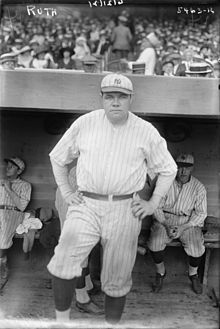
Babe Ruth holds sixteen franchise, four American League, and two Major League records.
The New York Yankees are a professional baseball team based in the Bronx, New York. They compete in the East Division of Major League Baseball's (MLB) American League (AL). The club began play in 1903 as the Highlanders, after owners Frank Farrell and William S. Devery had bought the defunct Baltimore Orioles and moved the team to New York City; in 1913, the team changed its nickname to the Yankees. From 1903 to 2023, the franchise has won more than 10,000 games and 27 World Series championships. The list below documents players and teams that hold particular club records.
Outfielder Babe Ruth holds the most franchise records, with 16, including career home runs, and career and single-season batting average and on-base percentage. Shortstop Derek Jeter has the second-most records among hitters, with eight. Jeter's marks include the records for career hits, singles, doubles, and stolen bases. Among pitchers, Whitey Ford has the most Yankees records with five, all of which are career totals. These include games won, games started, and innings pitched. (Full article...) -
Image 13Jackie Robinson, the inaugural winner in 1947 and eventual namesake of the award
In Major League Baseball, the Rookie of the Year Award is given annually to two outstanding rookie players, one each for the American League (AL) and National League (NL), as voted on by the Baseball Writers' Association of America (BBWAA). The award was established in 1940 by the Chicago chapter of the BBWAA, which selected an annual winner from 1940 through 1946. The award became national in 1947; Jackie Robinson, the Brooklyn Dodgers' second baseman, won the inaugural award. One award was presented for all of MLB in 1947 and 1948; since 1949, the honor has been given to one player each in the NL and AL. Originally, the award was known as the J. Louis Comiskey Memorial Award, named after the Chicago White Sox owner of the 1930s. The award was renamed the Jackie Robinson Award in July 1987, 40 years after Robinson broke the baseball color line.
Nineteen players have been elected to the National Baseball Hall of Fame—Robinson, seven AL players, and eleven others from the NL. The award has been shared twice: once by Butch Metzger and Pat Zachry of the NL in 1976; and once by John Castino and Alfredo Griffin of the AL in 1979. Members of the Brooklyn and Los Angeles Dodgers have won the most awards of any franchise (with 18), twice the total of the New York Yankees, and members of the Philadelphia and Oakland Athletics (eight), who have produced the most in the AL. Fred Lynn and Ichiro Suzuki are the only two players who have been named Rookie of the Year and Most Valuable Player in the same year, and Fernando Valenzuela is the only player to have won Rookie of the Year and the Cy Young Award in the same year. Sam Jethroe is the oldest player to have won the award, at age 32, 33 days older than 2000 winner Kazuhiro Sasaki (also 32). Gunnar Henderson of the Baltimore Orioles and Corbin Carroll of the Arizona Diamondbacks are the most recent winners. (Full article...) -
Image 14
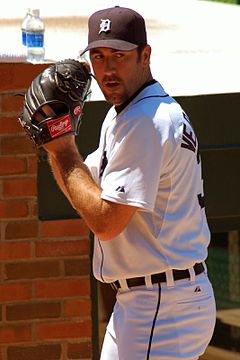
Justin Verlander (2004) is the only first-round pick of the Detroit Tigers to win the Rookie of the Year award.
The Detroit Tigers are a Major League Baseball (MLB) franchise based in Detroit, Michigan. They play in the American League Central division. Since the institution of MLB's Rule 4 Draft, the Tigers have selected 66 players in the first round. Officially known as the "First-Year Player Draft", the Rule 4 Draft is MLB's primary mechanism for assigning players from high schools, colleges, and other amateur clubs to its franchises. The draft order is determined based on the previous season's standings, with the team possessing the worst record receiving the first pick. In addition, teams which lost free agents in the previous off-season may be awarded compensatory or supplementary picks.
Of the 66 players picked in the first round by Detroit, 32 have been pitchers, the most of any position; 25 of these were right-handed, while five were left-handed. Thirteen outfielders were selected, while five shortstops, five catchers, four third basemen, three first basemen, and two second baseman were taken as well. One additional player, Lance Parrish (1974), was drafted as an infielder but ultimately spent the majority of his Major League career at catcher. Thirteen of the players came from high schools or universities in the state of California, followed by Texas with ten players. The Tigers have also drafted five players from their home state of Michigan. (Full article...) -
Image 15The Most Valuable Player Award given to Hank Aaron in 1957
The Major League Baseball Most Valuable Player Award (MVP) is an annual Major League Baseball (MLB) award given to one outstanding player in the American League and one in the National League. The award has been presented by the Baseball Writers' Association of America (BBWAA) since 1931. (Full article...)
More did you know
- ... that brothers George Wright and Harry Wright both managed the Providence Grays National League baseball team?
- ... that Mike Cather earned his first major-league win in an 11-inning Atlanta Braves’ win, the same night the Braves earned the National League Eastern Division title?
- ... that in 1975, his only full season, Stan Perzanowski's earned run average was the lowest on the Texas Rangers?
- ... that Josh Gibson Field in Pittsburgh, Pennsylvania, is named for Negro League star Josh Gibson, who has been called the "black Babe Ruth?"
- ... that Ryota Igarashi used to hold the Nippon Professional Baseball record for the fastest pitch thrown?
Sports portals
Selected picture

| Credit: User:Braindrain0000 |
Major League Baseball has several blackout rules. Games are blacked out based on two criteria:
- A local broadcaster has priority to televise games of the team in their market over national broadcasters.
- FOX has certain rights for afternoon MLB games on Saturdays, and ESPN has the same rights for night games on Sundays.
Associated Wikimedia
The following Wikimedia Foundation sister projects provide more on this subject:
-
Commons
Free media repository -
Wikibooks
Free textbooks and manuals -
Wikidata
Free knowledge base -
Wikinews
Free-content news -
Wikiquote
Collection of quotations -
Wikisource
Free-content library -
Wikiversity
Free learning tools -
Wiktionary
Dictionary and thesaurus
More portals
- Portals with triaged subpages from June 2018
- All portals with triaged subpages
- Portals with no named maintainer
- Automated article-slideshow portals with 51–100 articles in article list
- Automated article-slideshow portals with 501–1000 articles in article list
- Random portal component with 41–50 available subpages
- Automated article-slideshow portals with 201–500 articles in article list
- Random portal component with 11–15 available subpages
- Random portal component with 21–25 available image subpages









